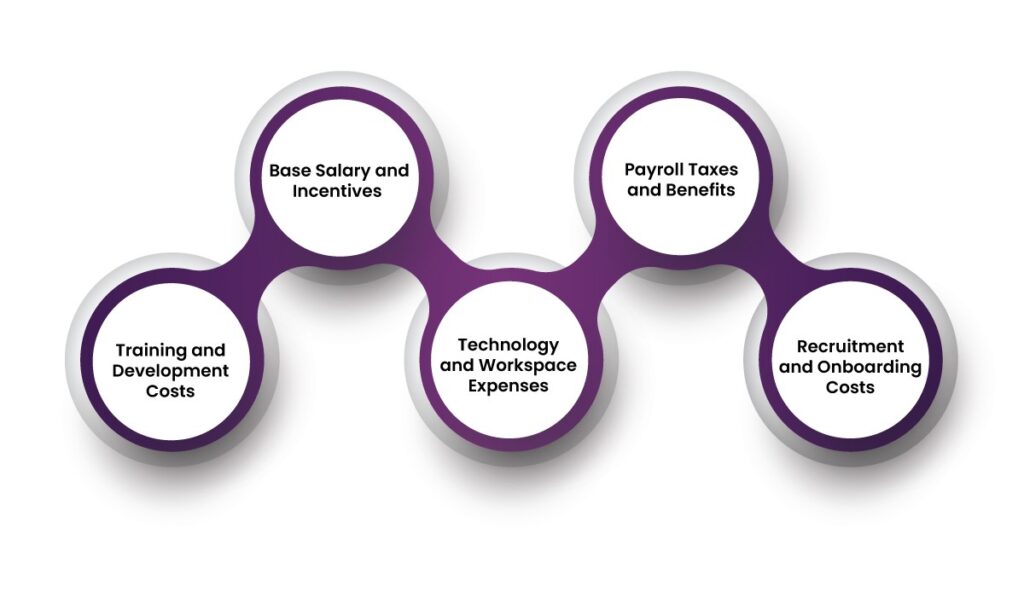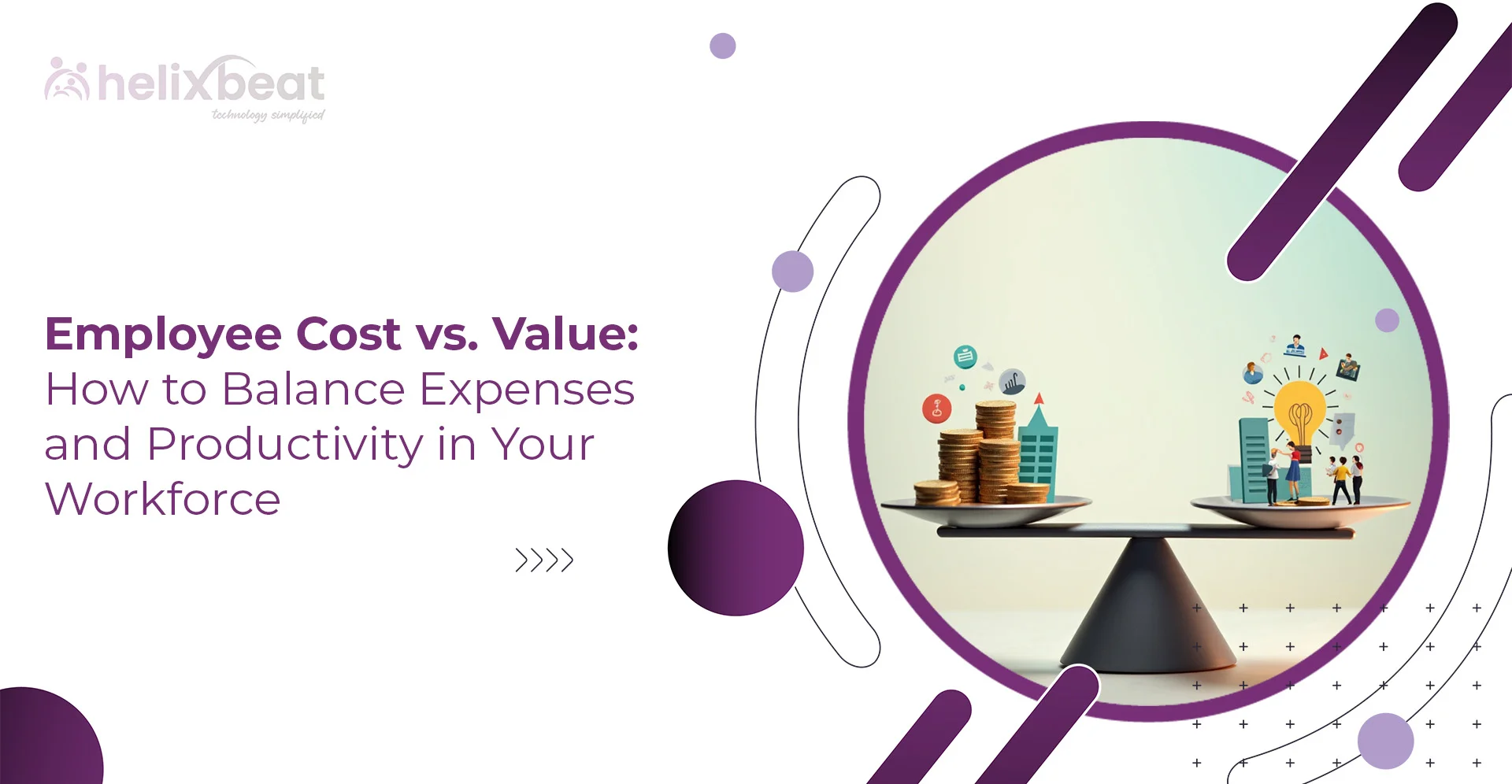Is your business spending too much on employees without seeing enough return? Employee costs play a crucial role in an organization’s financial health. However, reducing expenses without compromising productivity requires a careful balance. Entrepreneurs and business leaders constantly face the challenge of optimizing workforce expenses while maintaining high performance.
Understanding the true value of an employee goes beyond just their salary. Factors such as skill development, engagement, and technology significantly impact payroll budgeting and HR cost optimization. In this blog, we will explore how businesses can balance employee costs with workforce productivity while making data-driven decisions to maximize efficiency.
Table of Contents
What is Employee Cost?
Employee cost refers to the total workforce expenses incurred by a company to employ and retain workers. Managing these costs effectively is essential for maintaining profitability and operational efficiency.
Several factors contribute to overall employee cost, including:
- Base Salary and Incentives – The primary expense in payroll budgeting, which includes fixed salaries, performance-based bonuses, and commissions.
- Payroll Taxes and Benefits – Employers must account for health insurance, retirement contributions, and statutory taxes, all of which add to labor costs.
- Training and Development Costs – Investing in employee upskilling and reskilling ensures long-term productivity but adds to the budget.
- Technology and Workspace Expenses – Providing employees with the necessary tools, software, and office space contributes to HR cost optimization.
- Recruitment and Onboarding Costs – Hiring expenses, background verification, and onboarding programs significantly impact labor cost management.

A well-structured salary analysis allows businesses to evaluate compensation trends, ensuring competitive pay while preventing unnecessary overhead. Companies must find a balance between reducing employee costs and maximizing workforce efficiency to maintain a competitive edge.
By implementing data-driven HR strategies, businesses can streamline workforce expenses, optimize labor costs, and enhance overall financial sustainability.
The True Value of an Employee: More Than Just Numbers
While employee cost is a critical factor in business decision-making, the true value of an employee extends far beyond financial figures. Organizations that focus solely on cutting workforce expenses without considering long-term benefits risk losing top talent, reducing efficiency, and negatively impacting overall business performance.
A well-structured salary analysis and labor cost management strategy should not just be about minimizing expenses but optimizing them for the best return on investment. Employees contribute significantly in multiple ways, including:
- Increased Revenue Generation – Engaged employees drive business growth by enhancing sales, improving service delivery, and identifying new opportunities.
- Improved Customer Satisfaction – A motivated workforce leads to better customer interactions, ensuring long-term client retention and brand loyalty.
- Efficiency and Innovation – Investing in employee development leads to streamlined operations and innovative solutions, directly influencing business success.
- Stronger Workplace Culture – Employees who feel valued contribute positively to workplace morale, fostering collaboration and reducing turnover costs.
The key is not just to reduce payroll budgeting but to ensure HR cost optimization through strategic investments in employee well-being, training, and performance management. Businesses that align workforce expenses with productivity measures will achieve sustainable growth while maintaining financial stability.
How to Balance Employee Cost and Productivity?
Striking the right balance between employee cost and productivity is crucial for business sustainability. While reducing workforce expenses is important, it should not come at the cost of efficiency or employee morale. Instead, businesses should focus on HR cost optimization strategies that align financial planning with workforce performance.
1. Optimize Payroll Budgeting with Technology
Many organizations face inefficiencies in payroll budgeting due to manual errors and outdated processes. Implementing an automated payroll system, such as Synergy HRMS by Helixbeat, streamlines salary calculations, tax compliance, and benefits administration. By reducing administrative workload and ensuring accurate salary disbursements, businesses can cut workforce expenses while maintaining fair compensation.
2. Focus on HR Cost Optimization
Cost-cutting in HR doesn’t mean reducing salaries; rather, it involves strategic investments that yield higher returns. Businesses can achieve HR cost optimization by:
- Reducing high turnover rates through better employee engagement and retention strategies.
- Implementing hybrid or remote work models to lower office space and operational costs.
- Investing in continuous learning programs to enhance employee skills, thereby improving productivity without frequent hiring.
3. Use Workforce Data to Improve Decision-Making
Data-driven insights allow companies to make informed decisions about labor cost management and resource allocation. HR teams can track:
- Workforce efficiency metrics to measure output.
- Absenteeism trends that may impact productivity.
- Employee engagement levels to assess satisfaction.
- Industry salary analysis benchmarks for competitive compensation structures.
By leveraging tools like Synergy HRMS, businesses can use real-time analytics to refine their payroll budgeting and workforce planning.
4. Encourage Productivity Without Overworking Employees
While maximizing efficiency is essential, overburdening employees can lead to burnout and reduced performance. To strike a balance:
- Implement goal-based performance tracking rather than monitoring work hours.
- Reward employees based on measurable achievements instead of time spent.
- Provide automation tools to help employees complete tasks more efficiently.
5. Reduce Hiring Costs Through Internal Growth
Recruitment expenses can significantly impact workforce expenses. Instead of constantly hiring externally, businesses should:
- Upskill existing employees to take on advanced roles.
- Establish mentorship programs to promote leadership from within.
- Use AI-driven talent matching to fill internal job vacancies efficiently.
By aligning labor cost management with long-term employee development, businesses can enhance productivity while keeping employee cost under control.

How Synergy HRMS Helps Balance Employee Cost and Productivity?
Effective labor cost management requires a structured approach that aligns payroll, workforce planning, and operational efficiency. Synergy HRMS by HelixBeat is designed to help businesses streamline their HR processes, ensuring that employee cost remains optimized without compromising productivity.
Automated Payroll Management for Precise Payroll Budgeting
Managing payroll budgeting manually often leads to errors in salary calculations, tax deductions, and benefits administration. Synergy HRMS automates payroll processing, ensuring accuracy in salary disbursement while reducing administrative workload. This not only minimizes payroll discrepancies but also ensures compliance with tax regulations, ultimately contributing to HR cost optimization.
Real-Time Workforce Analytics for Better Decision-Making
Understanding workforce expenses requires data-driven insights. Synergy HRMS provides real-time analytics that help businesses perform salary analysis, track performance trends, and adjust compensation structures accordingly. By leveraging these insights, organizations can ensure that compensation aligns with employee contributions and industry standards.
Shift & Attendance Management for Improved Resource Allocation
Unplanned absenteeism and inefficient scheduling can increase employee cost without adding value. Synergy HRMS enables precise labor cost management by automating shift planning and tracking attendance in real-time. This ensures optimal workforce utilization and prevents unnecessary overtime expenses.
Expense & Leave Tracking for Cost Efficiency
Compensation and benefits must be structured to align with both employee needs and business sustainability. Synergy HRMS helps organizations track leave patterns and expenses, ensuring that employee benefits remain fair while avoiding excessive spending.
By integrating Synergy HRMS, businesses can take a proactive approach to workforce expenses, allowing them to maintain a balanced budget while maximizing productivity.
Final words
Balancing employee cost and productivity is essential for sustainable business growth. Rather than simply cutting expenses, companies should focus on strategic investments in talent, technology, and workplace culture. HR cost optimization, salary analysis, and payroll budgeting should be driven by real-time data insights to enable smarter workforce decisions.
Using an advanced HRMS like Synergy by HelixBeat can help businesses automate HR processes, minimize costs, and enhance productivity simultaneously. By leveraging technology, companies can ensure that every dollar spent on employees delivers maximum value while maintaining an efficient and motivated workforce.
FAQs
1. How can businesses reduce employee costs without affecting productivity?
Businesses can optimize payroll budgeting, invest in automation, and focus on employee development to reduce unnecessary costs while improving efficiency.
2. Why is payroll budgeting important for cost management?
Payroll budgeting ensures that companies allocate the right resources for salaries and benefits while maintaining profitability.
3. How does HR cost optimization impact business growth?
By optimizing HR costs, companies can reinvest savings into innovation, employee engagement, and business expansion.
4. What role does technology play in balancing employee costs?
HR software like Synergy HRMS automates payroll, attendance tracking, and workforce analytics, reducing manual errors and saving time.
5. How can businesses measure employee productivity?
Using performance analytics, goal tracking, and task management tools can help companies assess employee output and efficiency.














